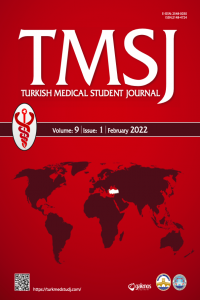RESEARCH OF URGENT BIOCHEMISTRY TEST ORDERING HABIT
RESEARCH OF URGENT BIOCHEMISTRY TEST ORDERING HABIT
Biochemistry, laboratories, emergencies,
___
- 1. Tiersten D. The “stat” problem. Clin Lab Med 1983;3(3):499-507.
- 2. Volmar KE, Wilkinson DS, Wagar EA et al. Utilization of stat test priority in the clinical laboratory. Arch Pathol Lab Med 2013;137(2):220-7.
- 3. Cathcart P, Emancipator K. Preventing overuse of stat testing. Lab Med 1997;28(3):165-6.
- 4. Hilborne L, Lee H, Cathcart P. STAT testing? A guideline for meeting clinician turnaround time requirements. Practice parameter. Am J Clin Pathol 1996;105(6):671-5.
- 5. Sucov A, Bazarian JJ, deLahunta et al. Test ordering guidelines can alter ordering patterns in an academic emergency department. J Emerg Med 1999;17(3):391-7.
- 6. Australasian College for Emergency Medicine, The Royal College of Pathologists of Australasia. Guideline on pathology testing in the emergency medicine. 2012. Available from URL: https://www.rcpa.edu.au/getattachment/8424e33b-8688-4c7d-b5ab-fbc4c38bccb9/ Pathology-Testing-in-the-Emergency-Department (11.09.2018).
- 7. Yılmaz FM, Kahveci R, Aksoy A et al. Impact of laboratory test use strategies in a Turkish hospital. PLoS ONE 2016;11(4):e0153693.
- ISSN: 2148-4724
- Başlangıç: 2014
- Yayıncı: Trakya Üniversitesi
THE INVESTIGATION OF UNIVERSITY STUDENTS’ KNOWLEDGE ON NUTRITION AND EATING HABITS
Ertuğrul KOÇAK, Atakan Muhammet PARLAK, Orkun Salih KIZILKAYA, Burak BARDAKÇI, Musa Eralp KILIÇ, Sevgi ESKİOCAK
RESEARCH OF URGENT BIOCHEMISTRY TEST ORDERING HABIT
Kubilay ELMACI, Betül İNCE, Sevgi ESKİOCAK, Eray ÖZGÜN
Berkay KEF, Nur Gülce İŞKAN, Kemal KEF
THE EFFECT OF PREVENTION FOR PEER BULLYING IN SECONDARY SCHOOL
Batuhan Mutlu, Şermin Yalın Sapmaz, Beyhan Cengiz ÖZYURT, İrem ŞENEL, Elif METİN, Melisa SARGUT, Riyadh SAEED, Bengisu UZEL TANRIVERDİ, Hasan KANDEMİR, Cevval ULMAN
THE EVALUATION OF MUSCULOSKELETAL SYSTEM TUMORS AND TUMOR LIKE LESIONS IN THRACE REGION
Ece ŞENYİĞİT, Begüm SÖYLEYİCİ, Nur Gülce İŞKAN, Hilal Sena ÇİFCİBAŞI, Aslı GÖZTEPE, Mert ÇİFTDEMİR
Varahabhatla Vamsi, Maganty Virajitha, Lihasenko Ivetta
